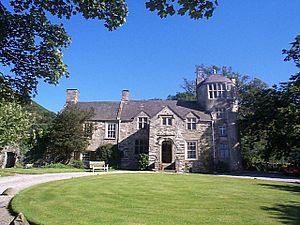Pen y Bryn facts for kids
Quick facts for kids Pen y Bryn |
|
|---|---|
 |
|
| General information | |
| Type | Manor House |
| Location | Abergwyngregyn, Aber, in Gwynedd, north Wales |
| Coordinates | 53°14′05″N 4°00′42″W / 53.234676°N 4.011712°W |
| Construction started | before the early 1600s |
Pen y Bryn is an old, two-story manor house located in Abergwyngregyn, Gwynedd, in north-west Wales. It's right next to the A55 highway. The house is about five miles east of Bangor and eight miles west of Conwy.
The house is built mostly from broken stone. It has special corner stones called quoins and a roof made of slate. Pen y Bryn sits within an area known as Garth Celyn. This area has a double bank and ditch, and it looks out over the Menai Strait towards Anglesey.
In 1811, a smaller house was next to Pen y Bryn. Sir Richard Colt-Hoare recorded it then. This smaller house was taken down by 1815. The current Pen y Bryn house includes a four-story stone tower. The wooden beams in the roof were checked using a method called dendrochronology. This showed they were from 1624, which is when the house was updated.
There is proof that the house was used for a long time before 1624. It was rebuilt many times. However, experts don't agree on how long it was used or what it was like during the Middle Ages.
Contents
Building Pen y Bryn
How the House Was Built
Between 1303 and 1306, a lot of building work happened in "Aber." This included bringing in broken stone and lime for mortar. Mortar is like glue that holds stones together.
There was another important old site nearby, on a mound called the Mŵd. But this site doesn't have broken stone walls now. It also might not have been big enough for all the building materials recorded.
In 1553, Rhys Thomas and his wife Jane bought the house from the Crown. The Crown means the royal family. The wood for the current roof was cut down between 1619 and 1624. The tower might have been added a bit later. More parts were added in the early 1700s and 1800s.
Exploring Garth Celyn
What is Garth Celyn?
Today, Garth Celyn is described by the Royal Commission on the Ancient and Historical Monuments of Wales (RCAHMW). It includes Pen y Bryn house, a large barn, and earth terraces. These features together form an enclosed area about 90 to 100 meters wide.
The name "Garth Celyn" means "Holly Enclosure" or "Holly Hill" in Welsh. The way the term "Aber Garthcelyn" was used has changed over time. As late as 1725, it could refer to the entire local area.
Garth Celyn's Importance
Modern Garth Celyn is a scheduled monument. This means it's a very important historical site protected by Cadw, a Welsh government group. An archaeological dig happened here in 1993. This dig was done by the Gwynedd Archaeological Trust. The site included other buildings, like a barn or gatehouse. This building might have been rebuilt around 1700 on older stone foundations. The current tower is also part of this complex.
The Royal Palace Mystery
Was This a Royal Palace?
There's a group called the Garth Celyn Trust. Their goal is to "protect and preserve Garth Celyn for the benefit of present and future generation." They also want to create a lasting memory of the Welsh Princes.
The Trust believes that modern Garth Celyn is where the royal llys (palace) was in the 1200s. They think it was the center of government before Wales was conquered. They also suggest that many important events in Welsh history happened right here.
Local Disagreement
There are local stories that point to Pen y Bryn, modern Garth Celyn, or Bryn Llywelyn as the site of the royal palace. However, there is a disagreement among local historians and groups about this. Some believe the evidence for Pen y Bryn as the palace site is not strong enough. They think another site in the village center, which was dug up in the 1990s and 2010s, is more likely to be the actual palace.
We know that a royal palace of the Welsh princes was in Abergwyngregyn. In November 1282, Prince Llywelyn ap Gruffudd wrote letters from "Garth Kelyn." In 1537, a historian named John Leland wrote about "The Moode." He said that Prince Llywelyn had a castle or palace on a hill near the church, and parts of it were still standing.
A very important building from the 1200s and 1300s has been found. It's thought to be the royal palace with its living and office buildings. This site is in the valley bottom, across the river, about 185 meters from Pen y Bryn. It's near the mound known as y Mŵd. In 1811, people in the area believed that visible remains near this mound were the palace of the Welsh Princes.
Images for kids
-
Pen y Bryn in 1811, a sepia drawing by Sir Richard Colt-Hoare


